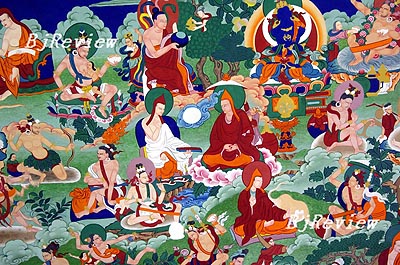
Crisp clean air, blue skies, snowy mountains and incense infused Buddhist temples. These are the images most people have of Tibet, the land of eternal mystery. And when it comes to the art treasures of the region, none is more intrinsically associated with Tibet than the iconic Tangkas.
Tangka, a Tibetan word, means a silk, satin or cloth painting scroll, and originated from the principal artistic schools of Western India (7th and 8th centuries), from which Tibetan painting takes its cue. Tibetan Tangka painting is based on the Indian religious art of pata (scroll painting on canvas) and mandala, intricate design styles used primarily in the course of specific religious rites. The paintings also serve as a historical record of the spiritual evolution of Tibet. It was not until the 18th century that Tibetan painting moved away from the ancient styles of Nepal and India, to be given new life through Chinese influence of brighter colors.
The content of most Tangkas are images of bodhisattvas (enlightened beings) and the design and painting is intricate and very time-consuming. Every part of the process is done by hand. A skilled painter needs almost 25 days to complete one step of the process. There are nine steps. Sometimes the artist can spend three hours painting a small flower. A completed Tangka could take anything from nine months to a year from start to finish.
The selection of the paint is a vital part of the painting process. All the pigments are natural, being minerals or plants, and this ensures the Tangka paintings remain vibrant hundreds of years after they are so lovingly created.
Apart from colorful painted Tangkas, there are also beaded Tangkas, pasted-embroidered Tangkas, leather thread Tangkas, applique Tangkas and even pearl Tangkas.
One of the most spectacular display of Tangkas takes place in August each year, during the celebrations of the Tibetan Shoton (Yogurt) Festival. Amidst horse racing, picnics and traditional Tibetan opera performances, gigantic Tangkas are literally unrolled down mountainsides in a blaze of color.
Rising value
For many years, Tangkas were not known to the Western world. But with the modernization of Tibet, the paintings have been turning up with increased frequency in local and international art collection markets.
At a sale of Christie's Auction House in New York in 1994, a large embroidered Tangka painted at the time of the Ming Dynasty (1368-1644) was sold for $1 million. In 2002, the same Tangka was sold again at Christie's Hong Kong for around $3.6 million, making it a record for any auctioned Tangka. However, nowadays it is rare to find Tangkas painted before the Ming Dynasty.
Apart from ancient classic works, created in Tang (618-907) and Qing (1644-1911) dynasties, modern Tangka paintings have also been favored by enthusiasts and collectors both domestically and overseas. Some works of contemporary artists have great value for collectors because of the painters' consummate skill and innovation of blending modern painting styles or approaches with traditional characteristics.
|